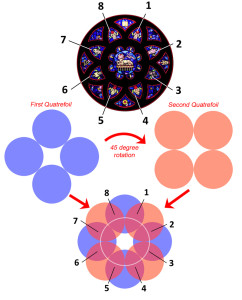This mandala has eight large outer circles that overlap. The basic structure is a simple Quatrefoil, i.e., four non-overlapping circles aligned North, South, East and West. What Pflueger has done it to take the first Quatrefoil, copy it to create a second, rotate the second Quatrefoil by 45 degrees, and then finally overlay the second onto of the first. (The image helps explain the geometry. Click on the image to enlarge it.) All the symbolism occurs in the area of the first Quatrefoil. Pflueger is simply using the second Quatrefoil to sub-divide the first. This creates a very elegant design, but Pflueger also has a very good reason for this approach.
Where the first and second Quatrefoils overlap a vesica piscis is formed. This is Latin for the bladder of a fish. Put another way, the area created by the intersection of the first set of four circles with the second set of four circles forms eight identical areas that look like a football which has been bitten in half. It is these eight areas (numbered at the bottom of the image) that we are interested in now.
A Quatrefoil is often used as a symbol for the four Gospel writers: Matthew, Mark, Luke and John. Pflueger uses the Quatrefoil for that purpose here, but because the Quatrefoil is subdivided into smaller sections he is able to add a second set of four significant individuals, Major Prophets.
The symbols break out as follows:
- Face of a Lion. Saint Mark.
- Turret. The Prophet Ezekiel.
- Tongs and hot coal. The Prophet Isaiah.
- Face of an Eagle. Saint John.
- Face of an Ox. Saint Luke.
- Scroll. The Prophet Jeremiah.
- Lion. The Prophet Daniel.
- Face of a Man. Saint Matthew.
The eight elements of this design are arranged with the four Gospel writers top and bottom, and the four major Old Testament Prophets left and right. Both sets of four writers teach us about Christ. Visually, the intention is for all eight of the symbols surrounding the central Agnus Dei to draw us to Christ.
It’s a really nice way of stating how the entire breadth of Scripture points to Jesus.
The inclusion of the four Prophets and the seated Agnus Dei in the mandala is unusual. In part 4C, I will suggest a possible explanation.

